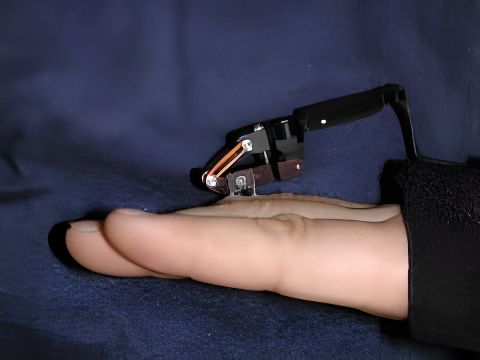Learn how a martial artist reversed a 70-degree finger contracture without repeat surgery.
What You’ll Learn in This Blog:
- How post-traumatic contracture affects active individuals and athletes
- Why traditional recovery paths may delay range of motion and full hand function restoration
- How Digit Widget uses biomechanical torque for post-trauma contracture treatment
- The recovery timeline and outcome of a martial artist who avoided repeat surgery
- How early intervention with the right trauma-related contracture treatment can dramatically accelerate rehab and reduce downtime
When an injury heals the wrong way, it can leave more than just a scar.
Trauma-related contracture can be a painful, often life-altering complication where the patient lacks PIP joint extension. Common after burns, fractures, or stroke, the patient’s mobility, independence, and daily function are limited.
Left untreated, trauma contracture can severely impact quality of life. Fortunately, there’s a minimally invasive PIP joint contracture treatment that restores finger function without the trauma and scarring of open procedures. Explore Digit Widget.
Learn more!
How Does a Hand Injury Turn Into a Debilitating Contracture for Active Individuals?
For highly active individuals, especially athletes, hand injuries don’t just cause pain—they disrupt identity. That was true for a 35-year-old martial artist who sustained trauma to his right ring finger during training. What started as a routine injury led to something more stubborn: a persistent flexion deformity that left his finger contracted at a rigid angle.


Can a 70-Degree Contracture Be Reversed Without Additional Surgery?
Under the care of Dr. Robert Slater, a hand surgeon with over 36 years of experience, the patient presented 9 months after the injury with a 70-degree flexion contracture at the PIP joint —too severe for functional grip, precise motion, or passive extension.
The patient was discouraged that, after months of dedicated orthopedic treatment, including splinting and therapy, progress was stalled. He couldn’t grip training gear or make a tight fist.. The idea of undergoing surgery —along with the extended downtime —was overwhelming.
Dr. Slater knew waiting for improvement would only prolong recovery. In athletes, delay often leads to compensation injuries, muscle imbalance, and psychological stress. What the patient needed was something minimally invasive, active, and biomechanically sound—a method that worked with his healing tissue, not against it.
Is There a Biomechanical Way to Make Contracture Treatment More Effective?
Dr. Slater recommended Digit Widget, a dynamic external fixator designed to treat post-traumatic contractures that resist conventional recovery. For patients like this martial artist, standard orthopedic treatment options such as static splints or passive stretching were unable to deliver the full correction needed for functional recovery.
Digit Widget works differently. It applies constant extension torque across the PIP joint using elastic bands that create a steady, continuous torque. This allows for gentle lengthening of soft tissue—tendons, ligaments, and fascia—without placing pressure on the skin.

Unlike splints, which are often uncomfortable or ineffective in severe cases, Digit Widget is designed for continuous wear. Its lightweight construction ensures it can be worn without irritation, pressure, or blisters, which enhances compliance and outcomes.
The patient followed the protocol with precision, maintaining appropriate tension and staying lightly active. Within weeks, his progress exceeded what typical orthopedic treatment did not achieve. Most importantly, he avoided additional finger surgery, regaining function without further trauma, scarring, or downtime.


For patients recovering from injury or persistent contracture, Digit Widget offers a proven, minimally invasive solution for finger surgeries.
How Digit Widget Reversed the Contracture for this Martial Artist
In just four weeks, the contracture reduced from 70° to 15°. The patient regained normal hand function, resumed modified training, and returned to daily activities, confident and pain-free.
Digit Widget’s orthopedic contracture treatment applied continuous extension torque without causing skin pressure or discomfort, allowing 24/7 wear and uninterrupted progress. Its minimally invasive, outpatient design helped avoid the trauma, cost, and scarring of repeat surgery.
Comfortable and easy to use, the device supported full compliance, a key to faster recovery. This case supports what many surgeons observe: when used early after trauma or surgery, Digit Widget promotes PIP joint extension and hand function, and restores range of motion mobility, often without further surgical intervention.
Ready to See It Work?
Whether you’re treating residual contracture or helping patients return to peak function faster, Digit Widget offers a proven, minimally invasive solution.
Contact us to learn how it can help your patients improve range of motion, accelerate rehab, and improve long-term hand function.
Powered by MarketEngine from StartupWind

